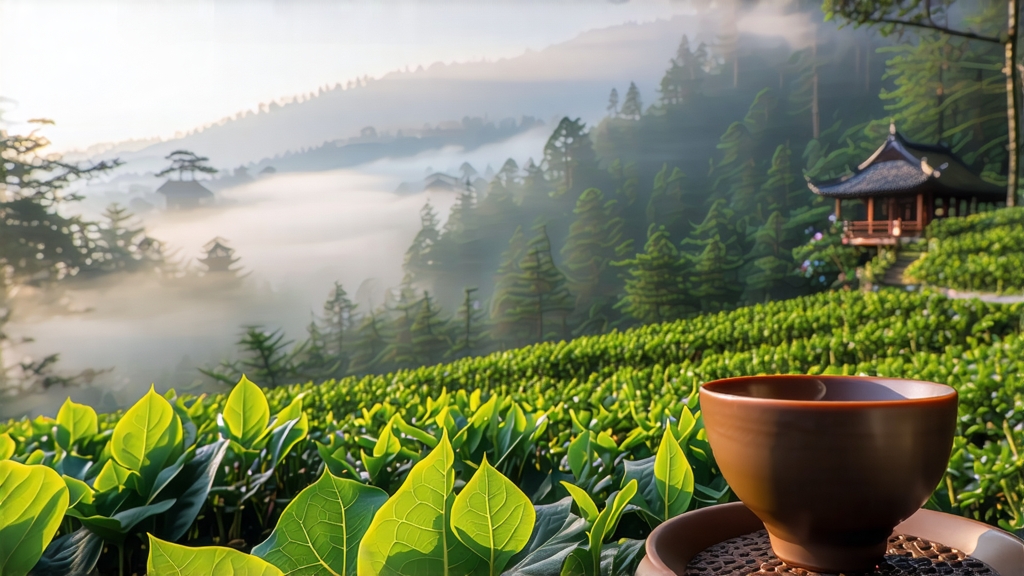
Alishan High-Mountain Oolong is not merely a tea; it is a vertical journey through the clouds. Grown between 1,000 and 1,400 metres on the ridge of Taiwan’s central mountain range, this cultivar absorbs forty days of natural mist each year, a phenomenon locals call “yun wu cha”—cloud and fog tea. The result is a liquor so luminous it resembles liquid jade, and an aroma so persistently floral that perfumers have tried, unsuccessfully, to bottle it.
History
Although Oolong itself was born in Fujian during the Ming dynasty, Alishan’s version is a twentieth-century child of migration and ingenuity. In 1895, when Taiwan became a Japanese colony, agronomists brought Qingxin Oolong (also spelled Chin-hsin or TTES #12) cuttings from Fujian’s Wuyi cliffs to the island’s interior. The Japanese wanted a black tea to rival Darjeeling, but the mountain air had other plans. Cool nights slowed leaf metabolism, concentrating amino acids and volatiles, while intense noon sun provoked a gentle, slow oxidation impossible at lower elevations. After World War II, Kuomintang veterans—many of them tea farmers from Anxi—refused to abandon the bushes. They adapted Wuyi’s bamboo-withering racks to the thinner air, shortened roast cycles, and created a style that is neither Fujian nor Formosa but entirely itself: Alishan High-Mountain Oolong.
Terroir & Harvest
The Alishan range is a stack of ancient slate and sandstone lifted by the Philippine Sea Plate. Its acidic, well-draining soil is poor in nitrogen but rich in porphyritic minerals that store daytime heat and release it after dusk. This diurnal swing—often 15 °C—coaxes the plant to produce more L-theanine and geraniol, molecules responsible for the tea’s signature cream-sweet mouthfeel and orchid nose. Only two flushes are plucked each year: spring (late March to early May) and winter (mid-October to late November). Leaves must be picked at dawn when dew weight exceeds 8 %, because surface moisture acts as a natural coolant during the long ride down hair-pin roads to the village processing centres.
Craft: The Eight Stages
- Solar Withering: Hand-picked leaves are spread on cloth-lined bamboo trays under filtered morning sun for 20–30 minutes. The goal is not desiccation but “leaf awakening,” a softening of cell walls that initiates enzymatic activity.
- Indoor Withering: Trays rest in a 22 °C, 65 % RH room for 6–10 hours, turned every hour. A delicate grassy note fades as precursors convert into floral lactones.
- Shaking: The most athletic step. Forty kilograms of leaves are tumbled in a waist-high bamboo drum rotating at 18 rpm for 3–5 minutes, then rested. This bruises edges without breaking veins, allowing partial oxidation while preserving the green core. The cycle repeats 5–7 times through the night; experienced masters listen for a rustle that sounds like “rain on paper.”
- Fixation: A 260 °C drum roaster halts oxidation at 18–22 %, lower than Dong Ding but higher than modern green Tieguanyin. The leaves emerge jade at the centre, mahogany on the rim.
- Rolling: While still warm, leaves are wrapped in cotton cloth and kneaded for 8 minutes in a mechanical press. Pressure is released every 30 seconds to allow moisture migration. The tight pellet shape locks in fragrance and withstands the high-altitude vacuum packaging required for global shipping.
- First Roast: 80 °C for 90 minutes reduces residual moisture to 7 %, stabilising the leaf for storage.
- Resting: Leaves sleep for 30–45 days in paper-lined wooden chests so that “fire qi” dissipates and flavour polymers harmonise.
- Finishing Roast: A gentle 60 °C charcoal ember roast for 2–4 hours, using longan wood only. The goal is not smokiness but a caramelised depth that rounds the bouquet.
Grades & Styles
- Qingxin Alishan: the classic, 100 % Qingxin cultivar, light roast, milky lilac aroma.
- Jinxuan Alishan: 30 % Jinxuan (TTES #12) blended for a creamier